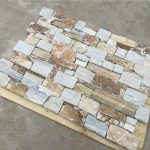Introduction:
In the world of home design and architecture, the use of stone trim has long been celebrated for its beauty, durability, and timeless appeal. Whether used as a decorative accent, a functional element, or a combination of both, stone trim has the ability to enhance the aesthetic appeal of any home. One popular option for homeowners looking to incorporate the look of natural stone into their design is cultured stone trim. This article will explore the benefits, versatility, and applications of cultured stone trim in home design, offering practical advice and inspiration for those considering this stylish option.
What is Cultured Stone Trim?

Cultured stone, also known as manufactured stone or faux stone, is a man-made product designed to replicate the appearance of natural stone. It is typically made from a mixture of cement, aggregates, and iron oxide pigments, which are poured into molds to create realistic stone-like shapes and textures. Cultured stone trim, specifically, refers to pieces of cultured stone that are used as decorative elements or architectural details in home design.
Benefits of Cultured Stone Trim:
1. Cost-Effective: One of the primary advantages of cultured stone trim is its affordability compared to natural stone. Cultured stone is generally less expensive to produce and install, making it a budget-friendly option for homeowners looking to achieve the look of stone without breaking the bank.
2. Lightweight: Cultured stone trim is significantly lighter in weight than natural stone, which can make it easier to transport, handle, and install. This lightweight characteristic also means that cultured stone trim can be applied to a wider range of surfaces without the need for additional structural support.
3. Variety of Styles and Colors: Cultured stone trim is available in a wide variety of styles, colors, and textures, allowing homeowners to choose the perfect option to complement their home's design aesthetic. From rustic and traditional to modern and contemporary, there is a cultured stone trim option to suit every taste and style.
4. Durable and Low Maintenance: Despite its lighter weight and lower cost, cultured stone trim is still highly durable and long-lasting. It is resistant to weathering, fading, and cracking, making it a low-maintenance choice for homeowners looking for a reliable and attractive exterior or interior trim option.
Applications of Cultured Stone Trim:
1. Exterior Trim: One of the most common applications of cultured stone trim is on the exterior of a home. Cultured stone trim can be used to accentuate architectural features such as windows, doors, eaves, and corners, adding visual interest and curb appeal to the façade of the house. It can also be used to create decorative elements such as columns, archways, and entryways, giving the home a sophisticated and elegant look.
2. Interior Trim: Cultured stone trim is not limited to the exterior of a home; it can also be used to enhance interior spaces. From fireplace surrounds and accent walls to kitchen backsplashes and bathroom vanities, cultured stone trim can add warmth, texture, and character to any room in the house. It can be used to create focal points, define spaces, or simply add a touch of luxury and style to the interior décor.
3. Landscape Trim: In addition to home design, cultured stone trim can also be used in landscaping projects to create borders, edging, retaining walls, and other decorative features. Its versatility and durability make it an excellent choice for outdoor applications, where it can withstand exposure to the elements and enhance the overall look of the outdoor space.
Tips for Installing Cultured Stone Trim:
1. Proper Surface Preparation: Before installing cultured stone trim, it is important to ensure that the surface is clean, dry, and free of any debris or contaminants. This will help the adhesive bond securely to the substrate and prevent any issues with adhesion or stability.
2. Use the Right Adhesive: When installing cultured stone trim, it is essential to use a high-quality adhesive specifically designed for stone applications. This will ensure a strong and durable bond between the cultured stone and the substrate, preventing any issues with shifting, cracking, or detachment over time.
3. Follow Manufacturer Guidelines: Different manufacturers may have specific instructions or recommendations for installing their cultured stone products. It is important to carefully read and follow these guidelines to ensure a successful and long-lasting installation.
4. Consider Professional Installation: While cultured stone trim can be installed by homeowners with some DIY experience, complex or large-scale projects may benefit from professional installation. A qualified contractor will have the expertise and tools necessary to ensure a precise and professional installation that meets industry standards.
In conclusion, cultured stone trim is a versatile, cost-effective, and attractive option for homeowners looking to enhance their homes with the beauty of stone. Whether used on the exterior, interior, or in landscaping projects, cultured stone trim offers a wide range of styles, colors, and textures to suit any design aesthetic. By following proper installation guidelines and considering professional help when needed, homeowners can achieve stunning results that elevate the look and value of their homes. Consider incorporating cultured stone trim into your next home improvement project to create a lasting impression and a timeless appeal.
